Chris-Craft 302 Crown

by David Pascoe
Our survey model was a 1992 model located in South Florida where it has had five years worth of all-season use. There were no engine hour meters, but judging by the fact that it had been mostly dry stored and had little wear and tear, it didn't look like this boat had been used much.
Style wise, this is your basic cocktail cruiser
with a wide beam all devoted to giving maximum interior space. The
cockpit is set up as a lounge with an L-shaped settee aft and to
starboard with small wet bar opposite with a removable table that
just about makes getting in and out of the lounge impossible, not
to mention docking or other operations. This thoughtful design gives
you three options of boarding: (1) via the built in swim platform,
(2) walking over your lounge seating and falling over the table,
and (3) stepping into the wet bar sink. Very clever, these designers.
We were also amused by the low-to-the-water swim platform with its
door opening without a door shown at left.
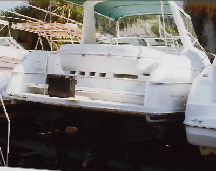
Stopping or backing down out in the open should be a real thrill in this one with the open stern only a few inches above the water line. Hopefully, the engines won't ever crap out in a nasty inlet or out at sea. Its got a lift up, swing out stainless steel gate that someone apparently decided to add to keep little tykes from wandering out there, that otherwise is a useless annoyance.
A starboard lounge seat facing a helm station wide enough for three so you can have an arm around each of your friends when you're running on autopilot while the folks sitting opposite have a bird's eye view of whatever it is that you're doing is cool. This is not a cruising layout for sure, and why anyone would create a three-man helm seat is beyond me. Actually, the helm set up is fairly comfortable for both standing and sitting operation, which is unusual. Except that you can't see a thing ahead of you while you're sitting down. At the rate boat collisions are occurring these days, looking where you're going doesn't seem to be much of a priority anyway, so why worry about that. The automobile-imitating bubble dash is not so good because you can't mount anything on the bubble, forcing you to try to place large instruments up under the swept-back windshield, essentially limiting you to small instruments; you won't get any large video recorders or radar units in this space. You're stuck with sprinkling your instruments around standing up like tin soldiers without the option of building anything in, and there's no space to add much of anything to the dash. The vinyl upholstery is thin and cheap.
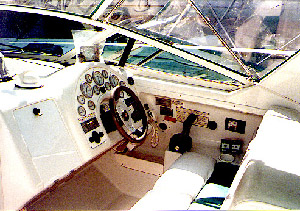
An otherwise decent helm set up is ruined by your basic automobile bubble dash on which you can't mount anything conveniently. The steering wheel looks more fit for a go-cart.
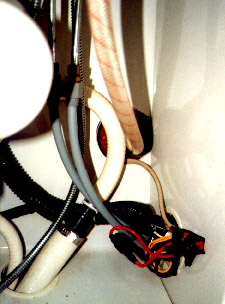
Some of the typical shoddy wiring. Here we have a bundle of wires with taped connection located under the head vanity.
The exterior glass work is very good and the general detail good - no unwanted bumps, lumps or ripples. The thing about Chris Craft is that they always make sure their products look good. The foredeck, cockpit and hull sides are fairly solid and we didn't find any stress cracks anywhere. But then we don't believe that this boat was used hard, either. The cleats are attached without backup plates on the underside. Hopefully there is no plywood core here where the handrails also bolted through. This boat has one of those wonderful bubble decks that darn near killed me because you can't stand up on them and I slipped and fell. For more details on this point, click on Bubble Decks
The wrap-around windshield is nicely styled and sturdy enough, but then they went and ruined a good thing by finishing it off with - get this - foam rubber moldings on the outside. What's wrong with that, you might ask? Well, sunlight, for one thing. Already the stuff had shrunk and all pulled loose and looked terrible; there's nothing to do but to replace them with more of the same. The Italian Faria engine gauges look great, too, until you realize that the bezels are painted aluminum and are corroding badly, ruining a helm set up that at least looks nifty. Then there was the matter of all those interior grade rocker switches on the dash (15 of them), five of which weren't working because water got in them. And never mind that the painted on lettering wore off in a few years. At least someone had the vision to realize that this would happen and so put on an extra set of engraved name plates.
The interior uses a full fiberglass inner liner which is nice if you simply want ease of cleaning because it certainly gives you that. Again, the glass molding work is good. But it also gives you a ride like a boxcar. There is no sound deadening in this one and it creaked and groaned something awful. Sitting at the dock, you can hear every oyster clicking and clacking on the bottom because the hull acts like a loud speaker, magnified by the liner. The two legged pedestal table was hopelessly wobbly and the coarse weave seating fabric was not holding up well.
For a 30 footer, the interior is large, but that's because the boat doesn't have any bulkheads up forward, the nearest one being the engine compartment, which is in the stern. Surely this contributes to wracking of the hull and much of the interior noise which is decidedly excessive. The deck is screwed to the hull but at least there is a wood backing strip on the back side. Through the hawse pipe for anchor rode, we could see that the foredeck is plywood cored and the laminate was completely separated at this point and soaking up water. Its too bad it wasn't rough the day we did the sea trial; it would be interesting to see what some wave action would do to this boat.
And speaking of bulkheads, the cockpit icemaker was leaking water onto the engine compartment bulkhead and it was starting to rot. The plywood was clearly marked C-D, meaning a roof sheathing grade material, complete with unfilled knots in the wood. Real garbage material that doesn't belong in a boat.
Installing the electric panel immediately inside the companionway door is a great way to get a dose of salt water in it, or on that inevitable day when you get caught by rain with the top down. Ah, well, its only the electric panel. And speaking of electrical, there is only one way to describe the wiring in this boat: a mess. Beneath that beautifully sculpted fiberglass inner liner there are wires helter-skelter every-which-way. A nice knob of taped-up wire connections was sticking out of a hole under the head vanity, ready to get wet and short out the first time something develops a leak around all that plumbing down there. Then we found a bundle of wires being pinched between a partition and the hull side with sharp edges cutting through the insulation. Plus there was lots of wiring laying on top of the fuel tanks. Hopefully none of these ever shorts out!
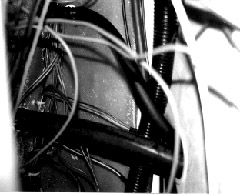
Wires here, wires there, wires everywhere. Here's a peek at what's behind the style and glamour. Many of these wires are in contact with the fuel tank.
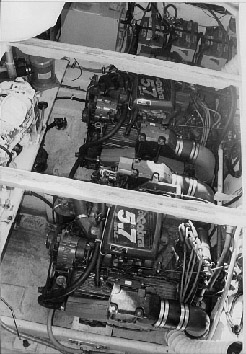
Engine compartment has fairly decent access, although the engines are jammed so close together you'll have a lot of fun changing sparkplugs and oil filters. And of course the bilge pump is under there too.
Then there was a 125 VAC electrical outlet under the aft berth just 4" above the bilge, into which the 12,000 BTU Cruisair airconditioner was plugged with a standard household connection. Guess what happens when the bilge pump fails? There are two shorepower inlet receptacles but no switching or circuit breakers on the main panel. We could only conclude that this shorepower was wired directly to the aforementioned outlet powering the A/C without benefit of circuit protection. As near as we can tell, this is a factory installation. Add to this the fact that the A/C condensation drain wasn't draining and the A/C wiring was being submerged in the deep drip pan. You could say that the owner should have cleaned this out, but the problem is that it is nearly impossible to reach.
Interested in the engine compartment? Well there's enough room that you can get in there to change oil and spark plugs without killing yourself, except that you can't reach them anyway. The engines are jammed together so that getting the inboard plugs out will be a lot of fun. If they had installed the Kohler generator off to one side instead of centered smack in front of the engines, you'd have a lot better access: you could actually have a place to sit down. The bilge pump, of course, was under the engines where you couldn't reach it.
The OMC 5.7 liter engines with stern drives had already had both risers and exhaust manifolds replaced on these sea water cooled engines. For those of you who wonder whether fresh water cooling is preferable, here's your answer. There were flush out ports installed, but let's be realistic: people don't change their oil (this one hadn't) yet alone take the time to do a flush out after every use. You've already got enough to do. Although there is adequate space, the designers didn't make the best use of it, and the systems installations are not exactly what I'd call "well done." Adequate might be a better adjective. As for the plumbing, its just plain sloppy with hoses strung helter-skelter.
One of the first things I'd do is replace the plastic, single lever OMC engine controls. Felt like the things were going to break off in your hand as you worked the controls. Not particularly smooth, either. Performance-wise this is a light boat and feels like a light boat, ergo it goes fast enough to break things in a hurry. The bottom is a moderate vee with a 6" wide flat spot along the keel which gets it up on step fast at the expense of a smooth ride from the moderately deep vee. A two foot sea will hold you back pretty good in this one.
Altogether this is a good looking boat that, beneath the exterior beauty is essentially your basic entry-level boat. If you know your way around boats and quality means something to you, you aren't likely to be happy with this one. Otherwise, to the unknowing it may be bliss. At least until the big repair bills start rolling in. This particular boat has led a sheltered life, but we suspect one with a little more use, say one which sat outside, afloat for 5 years, wouldn't have fared quite so well.
Posted January 25, 1998
 Visit davidpascoe.com for his power boat books
Visit davidpascoe.com for his power boat books 














David Pascoe is a second generation marine surveyor in his family who began his surveying career at age 16 as an apprentice in 1965 as the era of wooden boats was drawing to a close.
Certified by the National Association of Marine Surveyors in 1972, he has conducted over 5,000 pre purchase surveys in addition to having conducted hundreds of boating accident investigations, including fires, sinkings, hull failures and machinery failure analysis.
Over forty years of knowledge and experience are brought to bear in following books. David Pascoe is the author of:
In addition to readers in the United States, boaters and boat industry professionals worldwide from nearly 80 countries have purchased David Pascoe's books, since introduction of his first book in 2001.
In 2012, David Pascoe has retired from marine surveying business at age 65.
On November 23rd, 2018, David Pascoe has passed away at age 71.
Biography - Long version